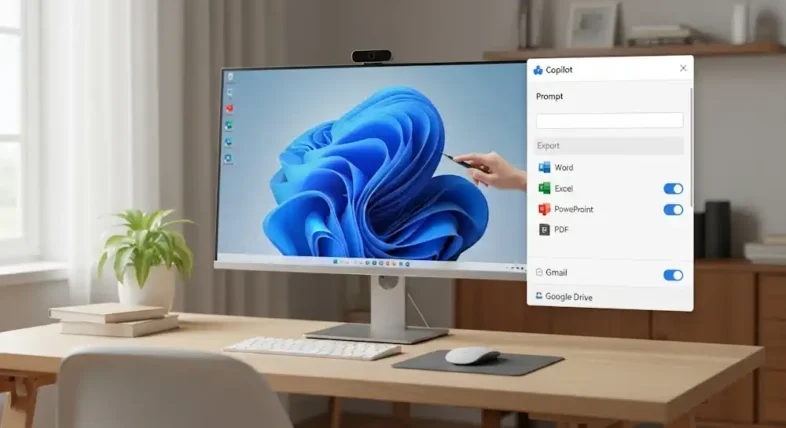Microsoft is turning the Copilot app on Windows into more than a chat sidebar. A new preview rolling out to Windows Insiders introduces opt-in Connectors for popular Microsoft and Google services and a streamlined way to export AI responses directly into Office and PDF formats. The package arrives via the Microsoft Store and is staged by device and channel, so availability can vary.
Together, these additions aim to reduce context switching and make Copilot a hub for quick retrieval and document creation. Early testers report that longer responses now surface a visible export option, which helps shift AI generated content into standard files with fewer steps.
Table of Contents
What Is New: Connectors and Document Export
The headline change is Connectors, an opt-in capability that lets users link Copilot with services such as Outlook, OneDrive, Gmail, Google Drive, Google Calendar, and Google Contacts. When enabled, Copilot can use natural language prompts to find emails, surface calendar details, and retrieve files across connected accounts. The intent is to put cross-account context a prompt away, without juggling browser tabs or separate apps.
The second upgrade is one-click document creation. Inside Copilot on Windows, users can take a generated outline, summary, table, or draft and export it straight to Word, Excel, PowerPoint, or PDF. The export affordance typically appears on longer responses, allowing users to capture the result in a familiar file format for editing, sharing, or archiving.
How It Works For Insiders
The experience is delivered through an updated Copilot app for Windows. After installing the latest build, users can open Copilot, visit Settings, and choose which services to connect. Each connector requires explicit consent and can be disabled at any time. Once enabled, prompts such as asking for a class schedule from last week or requesting a colleague’s contact details will query the appropriate mailboxes, calendars, and cloud storage.
For document creation, ask Copilot to generate the content you need, then use the export control to send the result into a .docx, .xlsx, .pptx, or .pdf file. The exported file opens in the corresponding app for further edits. This reduces the back and forth between drafting in chat and formatting in Office apps.
Privacy And Control Considerations
Because Connectors bridge personal data across ecosystems, Microsoft emphasizes user control. Connections are opt-in, scopes are disclosed during setup, and users can disconnect any linked service from Copilot settings. These controls matter for individuals and organizations that want to test productivity gains without broadly exposing private information.
Good hygiene still applies. Review permissions during setup, verify which accounts you are linking, and periodically audit what is connected. For shared or managed devices, administrators may choose to limit connector access or test in a controlled Insider ring before wider deployment.
Why It Matters For Productivity
Many students and professionals split their work across Outlook and Gmail or keep files in both OneDrive and Google Drive. Connectors target that reality by bringing scattered context into one prompt-driven surface. The result can be faster retrieval of messages, schedules, and documents, especially when time is tight.
The export feature addresses another friction point. AI tools often help with first drafts, but getting that draft into a polished document takes extra steps. One click export lowers that barrier. Turning a summary into a Word file, a table into Excel, or a slide outline into PowerPoint becomes a single action that keeps momentum.
Limits And Best Practices
As with any preview, not every user will see all features immediately. Rollouts can be staged, and some capabilities may rely on server-side flags. If a connector or export option is missing, check for app updates and try again later.
Quality review remains essential. Treat AI output as a starting point, then fact-check numbers, verify names and dates, and refine language. For documents intended for clients or public distribution, build a quick checklist that covers accuracy, tone, and formatting before exporting or sharing.
The Bigger Copilot On Windows Picture
These changes are part of a broader direction that places Copilot at the center of daily workflows on Windows. Beyond content generation, Microsoft is testing ways for Copilot to perform light system actions and to coordinate with first-party and third-party services. The goal is a unified assistant that can retrieve, create, and adjust from a single canvas.
If Connectors gain traction, expect deeper, more granular integrations over time. That could include richer file previews, smarter disambiguation when multiple results match a prompt, and tighter handoffs into Office apps with templates and styles applied automatically.
What To Watch Next
Insiders should watch for broader availability across channels and for refinements to sign-in flows, permissions, and troubleshooting. Feedback around reliability and latency will likely shape how quickly the features graduate from preview.
For everyday users, the practical test is simple. If Connectors reduce time spent hunting through inboxes and cloud folders, and if export reliably converts drafts into clean, editable files, Copilot on Windows will move closer to a daily driver role. The latest preview is a meaningful step toward that outcome, bringing cross-account retrieval and one-click document creation into one place.


